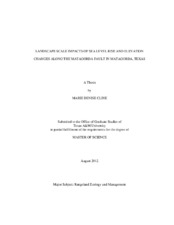| dc.contributor.advisor | Feagin, Rusty A. | |
| dc.creator | Cline, Marie | |
| dc.date.accessioned | 2012-10-19T15:30:39Z | |
| dc.date.accessioned | 2012-10-22T18:04:04Z | |
| dc.date.available | 2014-11-03T19:49:14Z | |
| dc.date.created | 2012-08 | |
| dc.date.issued | 2012-10-19 | |
| dc.date.submitted | August 2012 | |
| dc.identifier.uri | https://hdl.handle.net/1969.1/ETD-TAMU-2012-08-11643 | |
| dc.description.abstract | Movement of growth faults, a type of normal fault which is formed during sedimentation and is characterized by having greater vertical thickness on the downthrown fault side, on barrier islands contributes to wetland losses. The opening objective of this study was to quantify land cover change within a Matagorda, Texas wetland that results from sea level rise and elevation change over time due to coastal faulting. The closing objective of this study was to simulate land cover conversion as a function of relative sea level rise (RSLR) within the wetland and to compare and contrast the impact of specific rates of both fault-induced elevation change and predicted International Panel on Climate Change (IPCC) sea level rise projections.
To accomplish these objectives a time series of aerial images was classified using automated unsupervised classification and hand digitization. After classification, total wetland losses on both the upthrown and downthrown sides of the fault were evaluated as a function of spatial distance from the fault plane. This classified product was draped over a digital elevation model (DEM) layer to evaluate elevations of land cover classes and model potential future outcomes based on RSLR.
Classification results show that while wetland loss occurred on both sides of the fault, losses were far more extensive on the downthrown side. It was concluded that this vertical fault movement impacts wetland losses, especially on the downthrown side. Modeling results show that rapid water level rise can force wetland land cover class conversion regardless of whether this relative rise is caused by vertical fault displacement or eustatic sea level rise, resulting in the destruction of vital wetland areas. Current recorded conditions of sea level rise along the Texas Gulf Coast leave a grim outlook for regions similar to this study area. | en |
| dc.format.mimetype | application/pdf | |
| dc.language.iso | en_US | |
| dc.subject | wetland | en |
| dc.subject | sea level | en |
| dc.subject | fault | en |
| dc.subject | landscape | en |
| dc.subject | land use land cover change | en |
| dc.subject | classification | en |
| dc.subject | modeling | en |
| dc.subject | climate change | en |
| dc.title | Landscape Scale Impacts of Sea Level Rise and Elevation Changes Along the Matagorda Fault in Matagorda, Texas | en |
| dc.type | Thesis | en |
| thesis.degree.department | Ecosystem Science and Management | en |
| thesis.degree.discipline | Rangeland Ecology and Management | en |
| thesis.degree.grantor | Texas A&M University | en |
| thesis.degree.name | Master of Science | en |
| thesis.degree.level | Masters | en |
| dc.contributor.committeeMember | Popescu, Sorin | |
| dc.contributor.committeeMember | Grant, William E. | |
| dc.type.genre | thesis | en |
| dc.type.material | text | en |
| local.embargo.terms | 2014-10-22 | |


